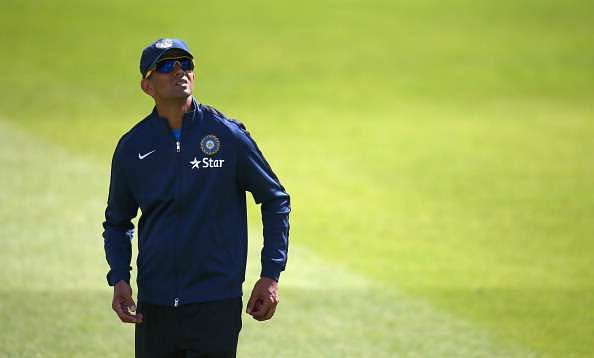
Why India should appoint Rahul Dravid as the next full-time coach
The Indian team has been coach-less since late 2014, when Zimbabwean coach of international note, Duncan Fletcher’s tenure ended on the back of a few seasons of mediocre results. Fletcher, who enjoyed a considerable amount of success with the English team, overseeing a brilliant turnaround in the team’s fortunes at the turn of the century under Nasser Hussain’s captaincy, was perhaps unfairly criticized for the results of the team, despite then-captain MS Dhoni’s repeated assertions that the coach had and has, generally, very little bearing on the results of the team.
Despite not having a full-time coach, India have had a Team Manager of sorts in Ravi Shastri, who notwithstanding his flaws, has displayed dynamism and nous at the helm. Players and fans alike have observed his unembellished approach to the game and his “the hell with results” philosophy, and have resonated with it.
Shastri asserted that the process is paramount when working with a team that had lost as many experienced players as it did in the last few years. But the results haven’t been in Shastri’s favour: India lost away series across formats to Australia twice and Bangladesh, and the limited-overs legs of a home series to the then number one ranked side, South Africa. His technical credentials have been questioned, and it has also been a point of debate as to whether he could carry on as a full-time coach.
But the BCCI has stated in a presser earlier in the month that a full-time coach would be appointed in the days following the World Twenty20, looking ahead to the away test series of four matches against the West Indies.
The BCCI had appointed an advisory committee late last year consisting of Sourav Ganguly, Sachin Tendulkar and VVS Laxman to aid in the appointment of a full-time coach.
A number of names have been doing the rounds, including former Australian opening batsman Justin Langer, who has a brilliant track-record as a Sheffield Shield coach, former New Zealand captain and coach of the now-defunct CSK IPL franchise, Stephen Fleming and even John Wright. But perhaps the most interesting name of all has been India’s eponymous number three and India U-19 coach, Rahul Dravid.
Since retiring from international cricket, Dravid has been active in various capacities: a successful captain for the Rajasthan franchise of the IPL, India-A coach and now, the coach of the India U-19 side. Dravid was appointed in this challenging role in the early part of 2015, which demanded working with unfinished talent picked straight out of the age-level sides.
Dravid’s incredible cricketing brain and his technical acumen have been instrumental in recognizing and grooming talent in coaching roles that demand intuitiveness and a keen eye, as raw talent sometimes has no solid results to back it. Dravid’s coaching role essentially culminated in India’s disappointing U-19 World Cup final loss to the West Indies.
The West Indies’ Cinderella Story began with a Group-Stage victory over Zimbabwe in controversial circumstances when bowler Keemo Paul ‘mankaded’ a Zimbabwean tailender to move through to the knockout stage. The match, and the Mankad, incited a raging debate over the legality of the Mankad and the unwritten ethical code violated by the West Indies, but nevertheless it polarized fans, critics and former players.
India were widely expected to win the tournament, entering as clear favourites after Australia refused to play in Bangladesh, citing security reasons. The tournament was following the script as India entered the final on the back of a few thumping victories, but on an uncharacteristically muggy morning at the Sher-e-Bangla in Dhaka, it really was the West Indies’ brilliant fast bowling that blew India away.
India were visibly disappointed at losing to an almost minnow side in the final, but realized they were outplayed. Keacy Carty’s 52(125)* chasing 145 to win summed up the West Indies’ stubborn attitude to the match. “Rahul Sir called for a party in the team room after the match, but we couldn’t enjoy”, claimed 17-year old Zeeshan Ansari, a touring squad member in the Indian U-19 side in Bangladesh.
“We talked a lot about the basics of the game. But the biggest thing I learnt was a lesson or two in humility”, he continues, when asked about what he learnt from Dravid in the few months he spent on the U-19 side. This is perhaps the biggest thing a raw and malleable young player could learn from Dravid: commitment, professionalism and humility.
The Indian senior team could surely use Dravid in the role of a full-time coach. Dravid’s success as a former international works hugely in his favour, despite a few exceptions, Mike Hesson being the most notable. His mellowness and placidity set him apart from other potential coaching candidates like Sourav Ganguly, who despite his excellent captaincy record and brilliant technical mind would probably not make an ideal coach in an environment where someone like Kohli would likely lead in all three formats in the future. No one wants to witness the Chappell-Ganguly fiasco again.
Dravid receives unnecessary flak for his allegedly poor captaincy record, and resigned soon after the disastrous 2007 World Cup in the Caribbean, but as test captain, led India to an away-series victory in England, one of the few Indian captains to do so.
His record away could be instrumental in improving India’s away record at present, with India having won just a handful of away tests in the last few years. Dravid could potentially be an era-changing captain, and his and Kohli’s deeply contrasting styles could form a smooth amalgamation of overall leadership and support.
But whoever the BCCI decide to go with, will definitely be supported by an extensive support staff, which includes people like Sanjay Bangar, who have been working hard behind the scenes, and whose roles should be, by no means undermined.

